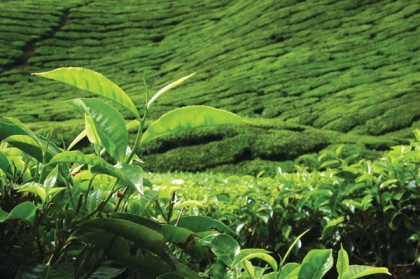Lipton & Taylor
Thomas Lipton & James Taylor
The history of Ceylon Tea, the finest Black Tea in the world runs far back to Sri Lanka’s British colonial period (1815-1948). Until the year 1869, Coffee industry of Sri Lanka, then called Ceylon was a lucrative business to the British colonial era planters of the resplendent Indian Ocean Island. Second to none among the planters, mainly British, was legendary Sinhalese Coffee planter, “Rothschild of Ceylon” Charles Henry De Soysa (1836-1890) of Moratuwa [of South-Western Coastal Belt of Sri Lanka Holidays], who prided on management of his estates with no European whatsoever on the payroll. But most of the Ceylonese executives were of European origin. The business of Ceylonese planters was business. They made money.
Ceylon Tea fields down in there in an exotic tropical island
As all good things must come to an end, in 1989, the death blow to the coffee industry was dealt in by the outbreak of a coffee rust, Hemileia vastatrix, a fungal disease. Such was devastation by the ‘coffee blight’, planters lost all hope on coffee. All of a sudden coffee was the bitter berry. Should you get tired of historical narratives, the next best option is fictional narratives based on facts. Standing head & shoulders high among all the fictional narrations of the grand enterprise is “the Bitter Berry” to hold you in thrall. The novel was written in by Christine Spittle Wilson, daughter of much adored Ceylonese Dutch burgher writer, Dr. R. L. Spittle (1880-1869) in 1957. It was translated from English into Sinhala by the title “Thitta Kopi” meaning Bitter Coffee in Sinhalese. But then the bitterness was not given an opportunity to take root. The lion-hearted planters wouldn’t be denied: new cash crop stronger than coffee plant was found. Undaunted & obstinate with courage, the planters carried on to establish legendary industry of Ceylon Tea, the finest Black Tea in the world, in the Sri Lanka Holidays Central Highlands beginning in Kandy, the gateway to the Central Highlands to Sri Lanka Holidays Nuwara Eliya, the prime hill country sanatorium.
Ceylon Tea: Brave Hearts
“Not often is it that men have the heart, when their one great industry is ruined, to rear up in a few years another as rich to take its place: and the tea fields of Ceylon are true a monument to courage as is the lion of Waterloo”.
Sir Arthur Connan Doyle (1859-1830)
Ceylon Tea: our man in Ceylon
“It can be said of few individuals that their labors have helped to shape the landscape of a country. But the beauty of the hill country as it now appears owes much to the inspiration of James Taylor, the man who introduced tea cultivation to Sri Lanka”.
John Field, the High Commissner for Great Britain in Sri Lanka, 1992, the 100th death anniversary of James Taylor
When the hour comes, the man would appear. Our man was only a boy when he arrived in resplendent Sri Lanka from Kincardineshire in 1852. He was sixteen. His name was James Taylor. James Taylor (1835-1892) during his time at a coffee plantation in Ceylon visited India (1866) to learn on growing Black tea. On his return in 1867, James Taylor pioneered the Black tea plantations of Ceylon in mere 19 acres of land.
In 1872, with a new variety of Black Tea from Assam discovered by another Scotsman, Robert Bruce, Taylor went on a much larger scale in plantations at Loolecondera estate in Sri Lanka Holidays Central Highlands. James Taylor has already been narrating his enterprise. “I have a machine of my own invention being made in Kandy for rolling tea which I think will be successful”, wrote Taylor. The year 1873 saw the export of Sri Lanka’s first Ceylon Tea consignment 23 lbs from Loolecondra Estate to London.
Ceylon Tea: Thomas Lipton was here
Although Ceylon Tea had become a popular beverage in Great Britain by 1880, it was still not within the purchasing capacity of the working class. In the year 1890, a British millionaire, who at the age of eighteen had picked up American techniques of salesmanship and advertising in New York, secretly booked a sea passage to Australia yet disembarked in Sri Lanka Holidays Colombo to close ranks with James Taylor to launch an enterprise of gigantic scale: “Straight from the tea gardens to the tea pot”. He had already taken a leaf out of the book his mother: his mother dealt directly with the farmers over the middlemen at the market to buy bacon, egg & butter for their small grocery shop at Glasgow, Ireland.
Ceylon Tea: Lipton came, Lipton saw, Lipton conquered
Thomas Lipton (1848-1931) resolved to leapfrog the industry of Ceylon Tea” “kill wherever possible, the middleman or intermediary profiteer between the producer and consumer, with profit alike to myself and my customer” (Lipton’s autobiography by Sir Thomas Lipton, 1932).
In 1891 Ceylon Tea established a record price of GBP 36.15 per pound at the London Tea Auctions. In 1893, an incredible one million packets of Ceylon Tea were sold at Chicago’s World Fair. Thomas Lipton became a household name across and the US. Lipton took Ceylon Tea to the world. And the world, in return, brought him greatest fame and fortune. In 1898, the Irishman was knighted by Queen Victoria.
Ceylon Tea: if you build it, they will come
And they came with great power. They came climbing, winding over the rings of hills, after hill, through the tunnels cut through the hills, over the bridges built over the rivers and ravines: the steam powered locomotive trains. They came to transport Ceylon Tea from the Sri Lanka Holidays Central Highlands to the seaport of Colombo for export. In the year 1884 the highland track of spectacular scenery built by Ceylon Railway Lines of British Ceylon was extended from Nanu Oya to Sri Lanka Holidays Nuwara Eliya and in 1894 to Sri Lanka Holidays Bandarawela and then in 1941 to Sri Lanka Holidays Badulla via paradise like village of Ella of the Central Highlands, the home of Black Tea branded Ceylon Tea, the finest Black Tea in the world.
![]()
Tags: Ceylon Tea, Nuwara Eliya, Sri Lanka Holidays












 Learn CPR and save a LIFE
Learn first-aid and save a LIMB
Learn CPR and save a LIFE
Learn first-aid and save a LIMB
